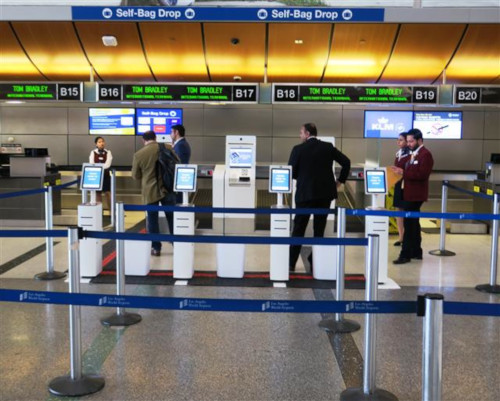LAX begins tests of state-of-the-art self-service bag-drop system

Guests flying out of the Tom Bradley International Terminal at Los Angeles International Airport have a faster, easy-to-use option for checking in their bags during the testing of a common-use, self-service bag-drop system that was unveiled in Aisles B and C of the ticketing lobby.
“A seamless, efficient and easy guest experience is key to creating a world class airport,” said Justin Erbacci, Interim Chief Executive Officer, Los Angeles World Airports. “By integrating state-of-the-art self-service bag-drop technology and improving each point of the passenger journey, we continue to transform LAX inside and out.”
Currently, the system can be used by customers flying with Asiana, Cathay Pacific, Lufthansa, and Norwegian airlines, with Scandinavian Airlines scheduled to be added on Wednesday. The pilot will later expand to also include Air France/KLM, ANA, British Airways, Korean Airlines, Singapore Airlines and EVA.
To use the new self-service system, a passenger must first print their bag tags using either the common-use self-service kiosks located near the front of the ticketing lobby or a smaller “Tag & Fly” unit installed in front of the bag-drop area. Once their bags are tagged, guests will go to the “Drop & Fly” bag-drop unit, which includes a conveyor belt to take bags to the main bag intake system.
The equipment is capable of using additional biometric technology, such as facial recognition, which may be tested later on.
Contracted staff from Pacific Aviation will be on hand to assist guests in using the technology. During this phase of the pilot, guests will scan their boarding pass to access the system. If bags are oversize or overweight, the staff will direct guests to go to their airline’s counter to complete their bag check-in. Guests who check in online with a participating airline can also receive a Quick Response Code that they can scan at the terminal to speed the experience further.
Signs are posted in front of Aisles A, B and C, and include the names of the participating airlines for guests who want to try the new system. To make room for the equipment, four ticket counters were removed in Aisles B and C.
During the pilot test, which is expected to last four to eight months, LAWA will be closely monitoring the system for processing times, the number of successful transactions and the number and types of failures, which could include both technical problems and user-generated errors. This data will be used to evaluate and refine the programme.


